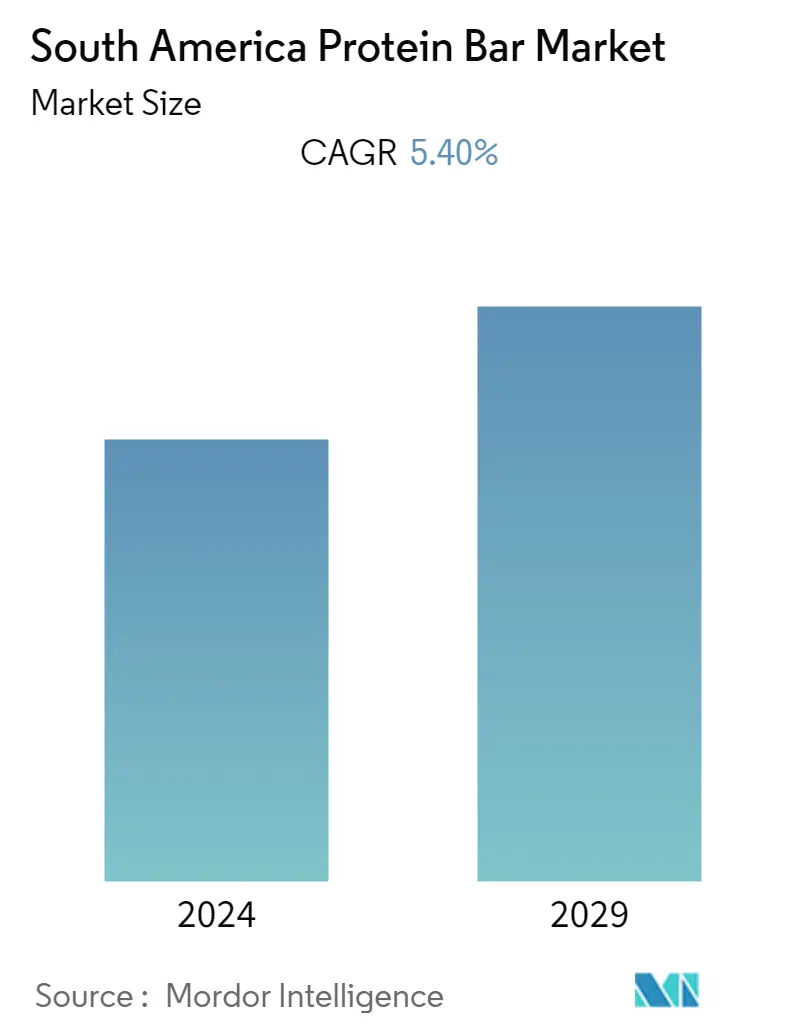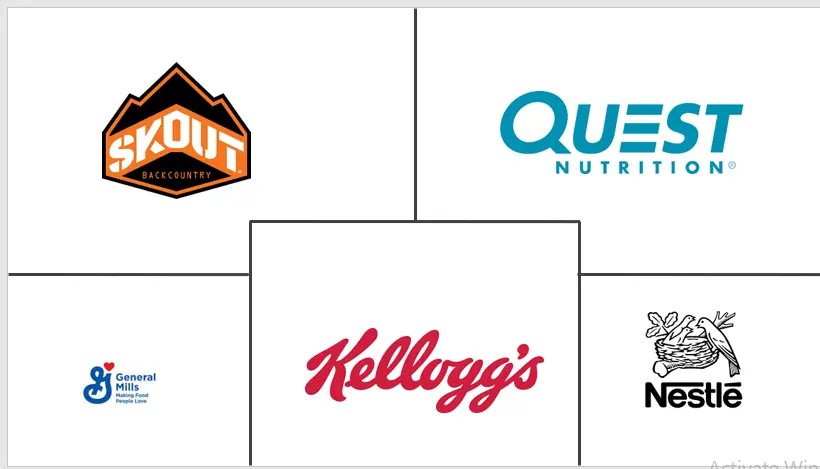Market Size of South America Protein Bar Industry

| Study Period | 2019 - 2029 |
| Base Year For Estimation | 2023 |
| Forecast Data Period | 2024 - 2029 |
| Historical Data Period | 2019 - 2022 |
| CAGR | 5.40 % |
| Market Concentration | Low |
Major Players
*Disclaimer: Major Players sorted in no particular order |
South America Protein Bar Market Analysis
South America protein bar market is projected to grow at a CAGR of 5.4% during the forecast period, 2020-2025.
- The protein bar market in South America is expanding from core users (bodybuilders and performance athletes) to a broader basket of consumers focused on fitness and healthy living trends.
- Moreover, rising health & wellness trends demanding low-calorie health food, consumer preference for snacking and on-the-go convenient packaging are various factors fueled the protein bar market growth.
South America Protein Bar Industry Segmentation
The South America protein bar market offers a range of products distributed through hypermarkets/supermarkets, convenience stores, online channels, specialty retailers, and other point of sales. Further, the study covers the regional level analysis of the major countries including Brazil, Argentina, and the rest of South America.
| By Distribution Channel | |
| Hypermarkets/Supermarkets | |
| Conventional Stores | |
| Online Channels | |
| Specialty Retailers | |
| Other Distribution Channels |
| By Geography | |
| Brazil | |
| Columbia | |
| Rest of South America |
South America Protein Bar Market Size Summary
The South America protein bar market is experiencing a notable expansion, transitioning from a niche focus on bodybuilders and performance athletes to a wider audience that includes fitness enthusiasts and health-conscious consumers. This shift is driven by increasing health and wellness trends, which emphasize low-calorie and nutritious food options. The demand for convenient, on-the-go snacks is also contributing to the market's growth, as consumers seek products that fit their busy lifestyles while offering substantial nutritional benefits. Countries such as Colombia, Chile, Paraguay, and Peru are witnessing moderate growth, with the market positioning itself between healthy snacks and convenient meal replacements.
In Brazil, the protein bar market has seen significant growth over the past five years, fueled by the increased availability of products and the development of major distribution channels. The emergence of regional brands offering competitive pricing has made protein bars more accessible to a broader segment of the population. Argentina is anticipated to lead the region in growth during the forecast period. The market is highly competitive, with both global giants like General Mills, Nestlé, and The Kelloggs Company, and regional players vying for market share. These companies are continually innovating their product lines to enhance market penetration and expand their customer base.
South America Protein Bar Market Size - Table of Contents
-
1. MARKET DYNAMICS
-
1.1 Market Drivers
-
1.2 Market Restraints
-
1.3 Porter's Five Forces Analysis
-
1.3.1 Threat of New Entrants
-
1.3.2 Bargaining Power of Buyers/Consumers
-
1.3.3 Bargaining Power of Suppliers
-
1.3.4 Threat of Substitute Products
-
1.3.5 Intensity of Competitive Rivalry
-
-
-
2. MARKET SEGMENTATION
-
2.1 By Distribution Channel
-
2.1.1 Hypermarkets/Supermarkets
-
2.1.2 Conventional Stores
-
2.1.3 Online Channels
-
2.1.4 Specialty Retailers
-
2.1.5 Other Distribution Channels
-
-
2.2 By Geography
-
2.2.1 Brazil
-
2.2.2 Columbia
-
2.2.3 Rest of South America
-
-
South America Protein Bar Market Size FAQs
What is the current South America Protein Bar Market size?
The South America Protein Bar Market is projected to register a CAGR of 5.40% during the forecast period (2024-2029)
Who are the key players in South America Protein Bar Market?
General Mills, Inc., Skout Backcountry LLC, Quest Nutrition, LLC, Nestlé S.A. and Arcor are the major companies operating in the South America Protein Bar Market.

